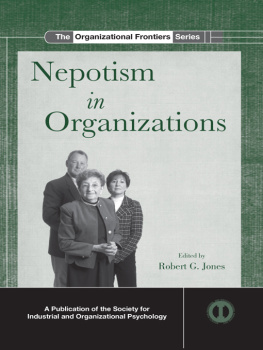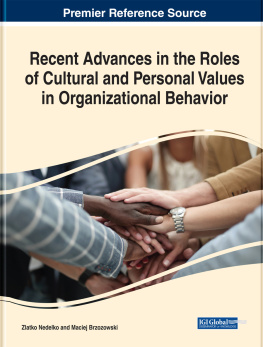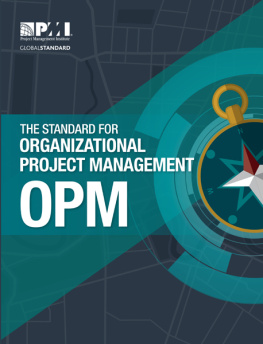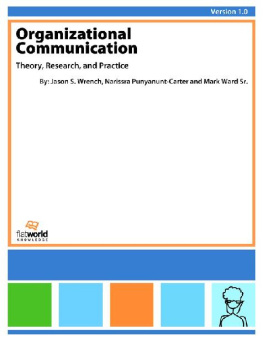Acknowledgments
Contrary to the popular myth, attempts at exploring frontiers are not usually accomplished through rugged individualism. Risk taking under conditions of uncertainty typically relies on mutual support. Perhaps the most famous explorations in history and science are identified with a single name (for example, Darwin, Erikson, Columbus, Curie), but closer scrutiny almost always shows this use of a single name to be at least an oversimplification, and often excludes major contributors. Perhaps the use of a single name has developed as a heuristic device to aid history students in remembering important events. Regardless, when we take risks, we usually rely on one another.
This Frontiers book is no different. The authors, editors, and Society for Industrial and Organizational Psychology Frontiers board members all took part in developing this volume. We all owe debts of gratitude to our academic and professional colleagues, mentors, and students. We also owe a debt to Adam Bellow for pioneering the book that inspired this one.
Perhaps most relevant to our efforts, and to this particular book, are the family members who supported our risk taking. Thanks to all who contributed.
About the Editor
Robert G. Jones, PhD, is professor of psychology and department head at Missouri State University. After a first career in music and banking, he returned to school to obtain his PhD in industrialorganizational psychology from The Ohio State University in 1992. In this second career, Dr. Jones and his students, colleagues, and clients have dealt with a broad range of issues in selection and assessment. Most of this work has focused on understanding and managing the bases for applied, person perceptionbased assessments, including emotive perception and prejudices. He has addressed these issues in various publications, numerous applied settings, and classrooms in the United States, Australia, and The Netherlands. As book review editor of Personnel Psychology (19992004), Dr. Jones had the pleasant task of reading lots of books, including the ones that inspired this one.
1
Defining a Ps ychology of Nepotism
Robert G. Jones
Missouri State University
There is an irony to one of the ultimate scenes in the movie Good Night, and Good Luck (Clooney, 2005), in which Jeff Daniels, playing a character similar to CBS executive Frank Stanton, has a candid, private conversation with two members of the CBS news team. The two are a closeted couple who have been hiding their marital relationship in the interest of preserving their jobs in an organization (CBS) with an anti-nepotism policy. Stanton was an industrialorganizational (IO) psychologist, and this scene was based on true events from the 1950s McCarthy era. Heres the irony: Although IO psychologists like Stanton have been dealing with the issue of nepotism in practice for a long time, our field has not yet defined this pervasive phenomenon or developed workable, empirically based approaches for managing it.
In this chapter, I will put forward the case for such a systematic study of nepotism. As a starting place, I will conceive a cautious, initial definition of the phenomenon from which future work can draw. A very brief description of associated historical themes and human resource practices will also be provided to establish a context for both research and practice. This will lead to an exploration of the larger question of the common engineering approach taken in IO psychology and juxtapose it to descriptive scientific inquiry. Throughout the chapter, I hope to provide both reasons and means for scientistpractitioners to integrate an understanding of this phenomenon into their work. In particular, while framing a new research area has importance for descriptive science, this book will also try to direct research toward a frontier that serves people in the workplace from the startby asking important questions. Finally, the chapters in the volume will be described.
TOWARD A WORK ING DEFINITION
This book will define nepotism (variously) as a set of psychological and social processes associated with observed phenomena with respect to family membership (broadly defined) in and around organizations. More specific definitions require attention to several issues, including the conflating of vernacular terms (Stich, 1993), the need to communicate with organizational clients (Klimoski & Jones, 2008), and providing too constricting a preliminary definition. Although the lions share of the definition process will rely on chapter authors, I also will define nepotism in this chapter, and review the definitions offered throughout the book in the final chapter.
As a starting place, nepotism can be defined in terms of both observed phenomena and potential underlying social and psychological processes. Regarding the observed phenomena, common understandings and popular definitions are a good place to start. The Oxford English Dictionary (2011) lists four definitions for the term, all of which are derived from the word nepos and the practice by early Christian bishops of conferring status on their nephews. The first definition is: a. The showing of special favour or unfair preference to a relative in conferring a position, job, privilege, etc.; spec. such favour or preference shown to an illegitimate son by a pope or other high-ranking ecclesiastic. The obsolete definition under this heading is b. In extended use: unfair preferment of or favouritism shown to friends, protgs, or others within a persons sphere of influence. Also (occasionally), the exploitation for ones personal advantage of ones influential status. Ironically, it is this latter, supposedly obsolete definition that appears to be the common use of the term, at least by reference to anti-nepotism policies that deal with more than just the relationship between managers and their nephews (Bellow, 2003). Following from the neutrality principle (see Mulder, this volume, ), I will drop the unfair component of this definition in order to direct discourse toward understanding the phenomenon descriptively.
There are several other general definitions of nepotism. A putatively traditional definition is the bestowal of patronage by reason of relationship regardless of merit (Simon, Clark, & Tifft, 1966). Bellows (2003) initial definition of nepotism is favoritism based on kinship (p. 11). But he also defines a new nepotism, which involves deliberate occupational choice by offspring. Jones and colleagues (2008) go further, suggesting that nepotism be defined by distinguishing nepotism as a hiring decision based solely on family ties (kinship) versus a career choice that leads to hiring based on merit. Stout, Levesque, and Jones (2007) encompass both this deliberate career choice and meritorious hiring of family members, but further broaden the definition in terms of familial coercion. The obvious conclusion here is that the common definition of nepotism based on observer perceptions of favoritism actually belies several underlying processes.
In order to define underlying psychological variables associated with observed phenomena, a short foray into research on animal behavior is informative. This research suggests that nepotism is defined narrowly in terms of preferential treatment on the basis of closer versus more distant genetic relationships (Park, Schaller, & Van Vugt, 2008). One problem with this definition is that it is based entirely on inferences from behavioral tendencies rather than from any notion of precursor constructs or effectiveness criteria. It also appears to differ between species (Park et al., 2008; Zinck, Chline, & Jaisson, 2009), making it difficult to identify a strictly human definition of any psychological phenomenon. Further, the effects of apparently nepotistic relationships tend to vary depending on other social organizing structures in higher mammals (Wittemyer & Getz, 2007). All this is to say that underlying variables are likely to be complex and multifaceted.















